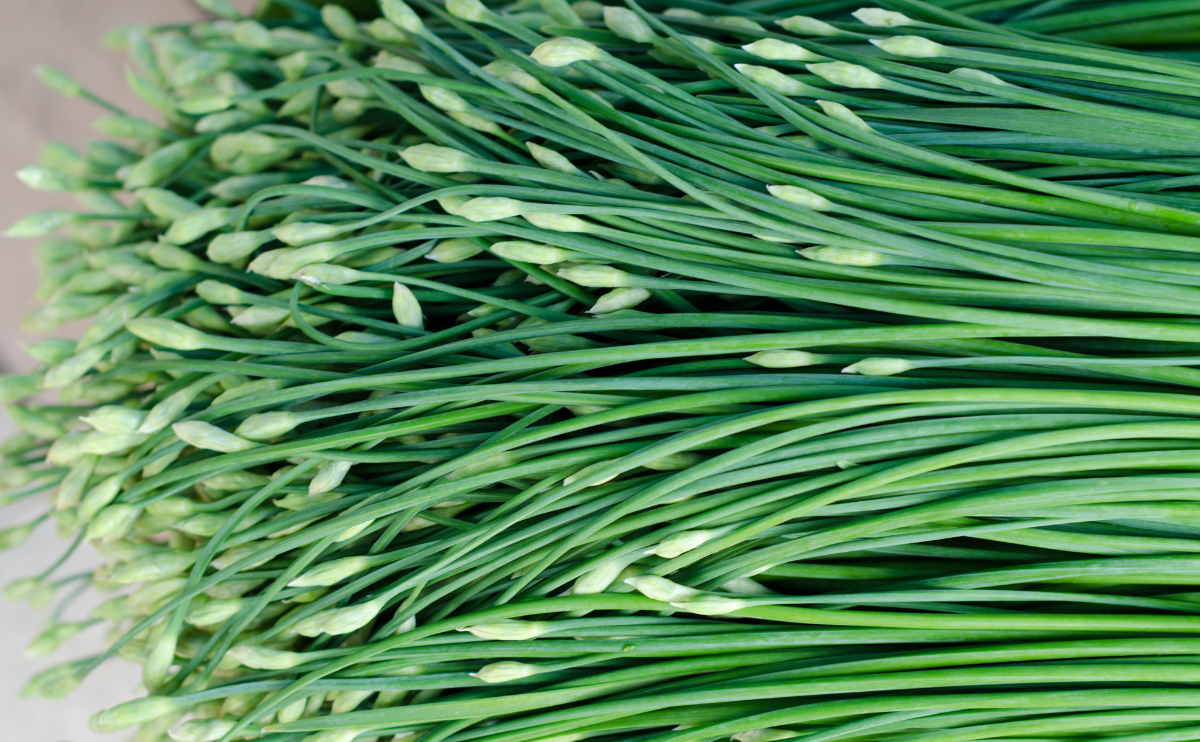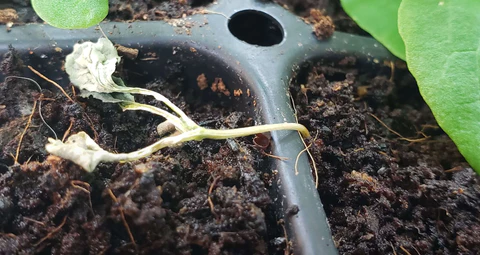Chives (Allium schoenoprasum) is an easy-to-grow, grass-like perennial herb in the same family as onion and garlic. It has a mild onion flavor that tastes great in salads or as a soup garnish. The attractive edible purple flowers also make it an interesting garden plant and garnish. Chives attracts bees and other pollinators at the same time it seems to repel other insects; it is sometimes planted among vegetables to discourage Japanese beetles and other damaging insects.
These cold-tolerant perennials are ideal for more temperate regions and are usually planted from nursery sets in early spring to give a generous harvest beginning in late spring. If planted from seeds, they will reach harvestable maturity in about two months.

| Botanical Name | Allium schoenoprasum |
| Common Name | Chives, common chives |
| Plant Type | Herbaceous, perennial |
| Mature Size | 10-15 in. tall, similar spread |
| Sun Exposure | Full sun, light shade |
| Soil Type | Loamy, sandy |
| Soil pH | Slightly acidic to neutral |
| Bloom Time | Early summer |
| Flower Color | Lilac purple |
| Hardiness Zones | 3–9 (USDA) |
| Native Area | Europe, Asia, North America |
| Toxicity | Toxic to dogs, cats |
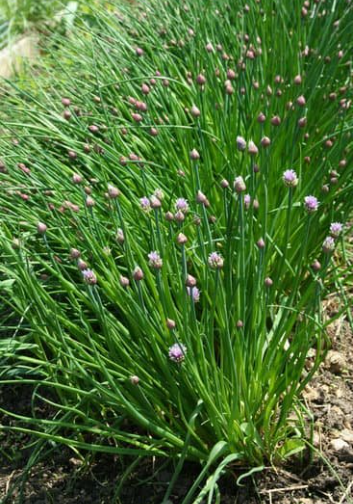
When to Plant?
This will be determined by your planting zone. There is a final frost date for each area. As a result, you can plan your gardening activities around this date. Check our Frost Dates Across North America: First & Last Frost Dates Chart. However, the date will not be the same for every plant.
How to Plant
The root system of this type of onion is branched and long, so take a deep pot. The best option is a pot with a depth of at least 8″. The pot’s volume is selected so that there is enough space to plant the chives at a distance of 2 – 4″ from each other and the pot side. Knowing the number of seeds, you can quickly determine the volume of the planting pot. Chives also grow well in container gardens and thrive indoors on a sunny windowsill.
Growing season: Chives will rise in air temperatures from 45°F to 95°F—spring through summer. You can plant chives in winter or fall in mild-winter regions. Avoid planting chives in wet soil that can encourage stem and bulb diseases. Grow chives in well-drained, sandy-loam, a soil rich in organic matter. Seeds should germinate in about 7 – 21 days at 70°F.
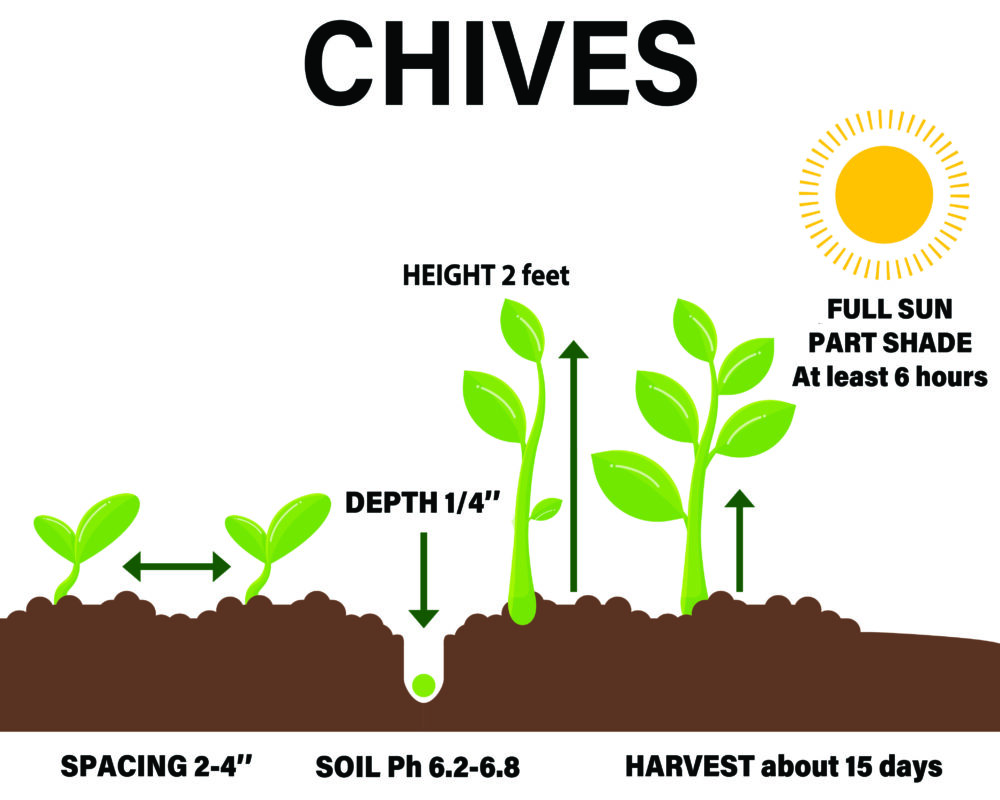
Chive is a cold-hardy perennial, a relative of the onion. The tips of chive leaves have a mild onion flavor. Chives are added to salads and used as a garnish for many cooked dishes. This herb can grow in containers with plenty of organic matter. Chives will grow in almost all soils. The ideal soil for this plant should be well-dug with the addition of well-rotted compost or organic material. Chives grow up to 2 feet tall. Companions – Onion, Apple, Beet, Carrot, Onions, and Garlic. Chives deter Japanese beetles and are said to deter black spot on roses, scab on apples, and mildew on cucumbers.
How to Cultivate
Soil – Average, well-drained. pH 6.2 to 6.8
Sun – Full sun to partial afternoon shade.
No fertilizer is needed if planted in reasonably fertile soil.
Frost tolerant – Very cold-hardy.
Spacing – 2 – 4″
How to Harvest
About 40 – 50 days after planting, you can harvest the first crop.
Cutting greens is efficient as soon as the length of the feathers reaches 8 – 12″.
Use sharp scissors to cut off bunches of leaves at a distance of 1 – 2″ from the soil’s surface.
Cut the chive leaves with scissors when required, starting with the outside leaves working your way inwards.
Always leave 2 inches of leaves remaining.
Hydroponics
Germination: To start the germination process, soak chive seeds in water for 24 hours before sowing them in your chosen hydroponic system.
pH range: The ideal pH range for chive hydroponic growth is between 6.0 and 7.0. Monitor the pH levels regularly and adjust them accordingly using pH up or down solutions.
EC: The ideal electrical conductivity (EC) range for chive hydroponics is between 1.2 and 2.2 mS/cm. Keep in mind that EC measures the level of nutrients in the solution, so you may need to adjust nutrient levels to maintain the appropriate EC range.
PPM: The ideal PPM (parts per million) range for chive hydroponics is between 600 and 1200 ppm. Again, this range will depend on the specific nutrients you use, so monitor the PPM levels regularly and adjust as needed.
Humidity: Chives prefer a relatively high humidity level, around 60-70%. Maintain proper humidity levels by using a humidifier or a humidity dome.
Light hours: Chives require at least 12-16 hours of light per day for proper growth. Use LED grow lights or natural sunlight to provide your plants with enough light.
Temperature air: Chive plants grow best in temperatures between 60-75°F (15-24°C). Make sure to maintain a stable temperature range in your hydroponic system.
Temperature water: The ideal water temperature for chive hydroponics is around 65-75°F (18-24°C). Too cold or too hot water can affect plant growth, so keep an eye on water temperature regularly.
That’s it! With the right conditions and attention, you should be able to successfully grow chives hydroponically.
Common Pests and Diseases
Downy mildew (Peronospora belbahrii)
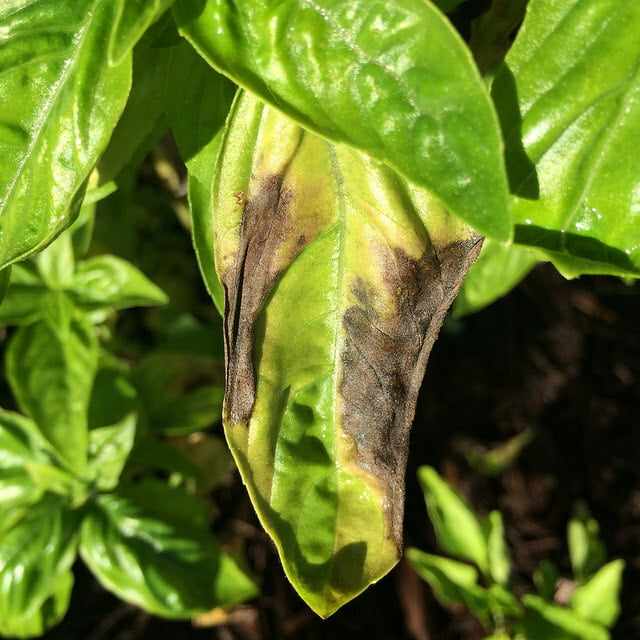
Symptoms: Yellowing leaves; discoloration often begins around the middle vein and spreads outwards; gray fuzzy or downy growth on the lower surface of the leaves; brown to black angular necrotic patches on the plant.
Cause: Fungus
Management
Grow tolerant varieties; apply protective fungicide; ensure good air circulation around greenhouse grown plants; use drip irrigation to avoid wetting foliage.

